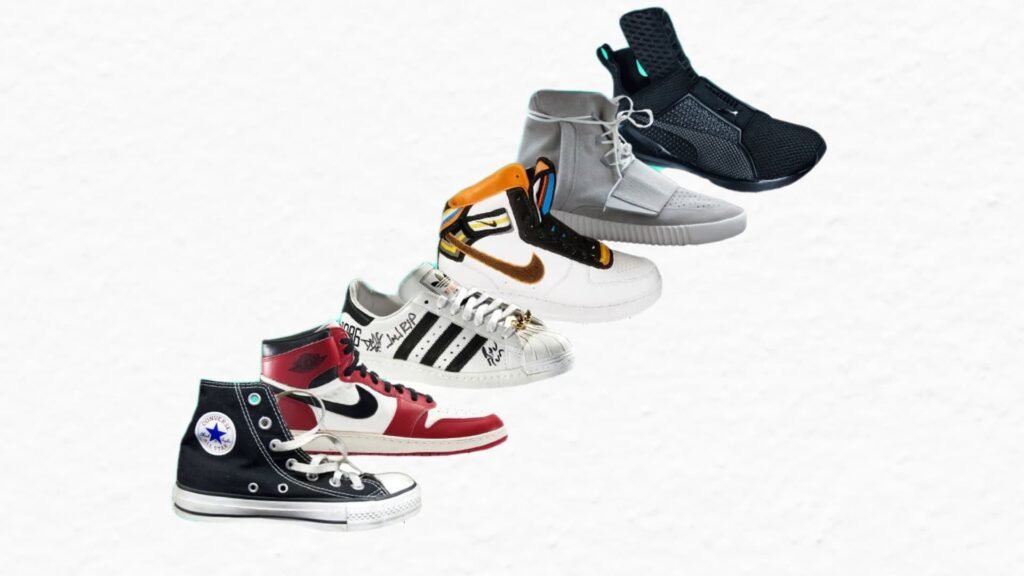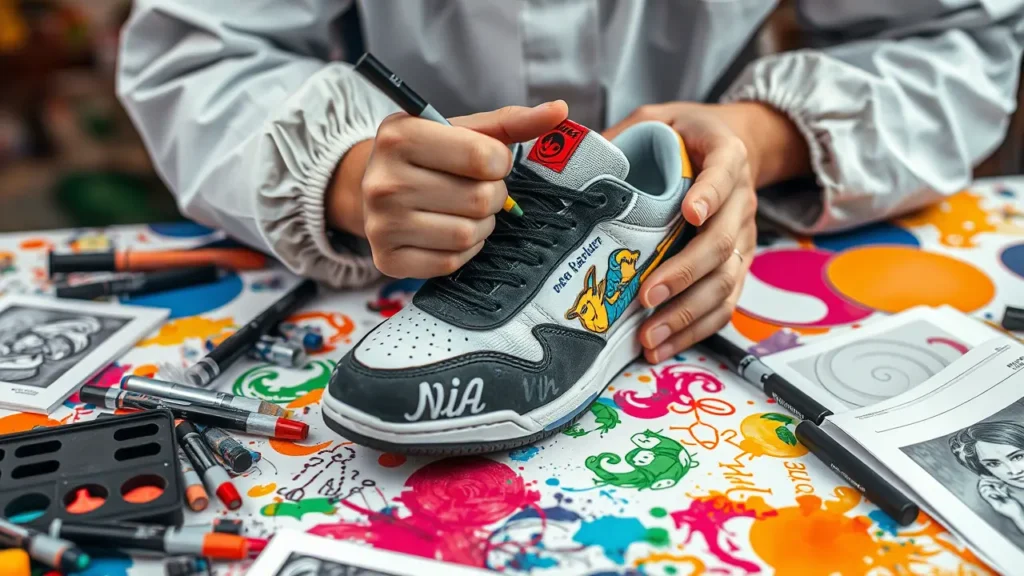Did you know that a single pair of sneakers once sold for over $1.8 million at auction? That’s not just fashion—it’s pop culture, history, and hype wrapped into one collectible object. In today’s world, sneaker collaborations have become more than just footwear; they are cultural artifacts that reflect the pulse of global trends, identity, and creativity.
You’ve probably seen them: limited-edition Air Jordans, Pharrell Williams’ NMDs, or Travis Scott’s upside-down Nike Air Force 1s. These aren’t just shoes—they’re statements. Sneaker collaborations are the result of partnerships between Nike, Adidas, Puma, and high-profile artists, designers, athletes, or influencers. They blend fashion, music, art, and sport into wearable pieces of culture.
What makes these collaborations so powerful is how seamlessly they connect with youth, influence trends, and shape identities across continents. From Tokyo to Toronto, Lagos to Los Angeles, sneaker collabs transcend borders. They reflect who we are, what we value, and where we want to go as a global society.
What Are Sneaker Collaborations and How Do They Work?
Sneaker collaborations are creative partnerships between footwear brands and external figures such as artists, athletes, musicians, or designers to create exclusive, limited-edition shoes. You see them dropping every few weeks on social media—hyped drops that sell out in seconds. But behind the frenzy lies a carefully orchestrated process.
First, a brand identifies a collaborator whose style, audience, and values align with its own. Then comes the design phase, where both parties co-create a unique look, incorporating personal motifs, cultural references, or innovative materials.
Finally, there’s the release strategy—limited quantities, surprise drops, and digital raffles—all designed to build exclusivity and demand.
The result? A product that feels personal, meaningful, and unmissable. These collaborations often include storytelling elements, from the inspiration behind the design to the narrative embedded in the colorways or materials used. It’s not just about selling a shoe—it’s about crafting an experience.
Sneaker collaborations don’t just follow trends—they set them. When you see a celebrity stepping out in a fresh pair of Dior x Jordan 1s or a streetwear influencer rocking Fear of God x Nike, it sends ripples through fashion, music, and even language.
These collaborations act as cultural barometers, reflecting what’s relevant and resonant in real time. They also blur the lines between industries.
A shoe can be an album cover, a concert staple, or a red carpet statement all at once. The visual and symbolic power of these designs spreads rapidly through social media, shaping aesthetics from TikTok dances to runway shows.
Because they merge lifestyle, identity, and storytelling, sneaker collabs don’t just ride the wave of pop culture—they create the tide. Their influence extends beyond footwear into broader lifestyle choices, influencing everything from haircuts to slang to how people consume entertainment.
Which Brands and Artists Have Created the Most Iconic Sneaker Collaborations?
Nike, Adidas, and Puma lead the pack when it comes to iconic sneaker collaborations, but it’s the artists and athletes they partner with that turn these shoes into legends.
You know the names: Michael Jordan changed basketball and fashion forever with the Air Jordan line. Pharrell Williams brought streetwear flair to Adidas with his Human Race NMD collection. Kanye West’s Yeezy line redefined minimalism and comfort in sneakers. Meanwhile, Travis Scott’s upside-down Swoosh on the Nike Air Force 1 became a symbol of rebellious cool.
These collaborations aren’t just products—they’re legacies. Each drop tells a story, builds a community, and sets a new standard for what a sneaker can represent. Other notable collaborators include Virgil Abloh (Off-White x Nike), KAWS (Nike SB Dunk), and even luxury houses like Louis Vuitton, which partnered with Supreme to redefine high fashion’s relationship with streetwear.
Sneaker collaborations are more than fashion—they’re platforms for expression, identity, and activism. You might have noticed how certain releases echo social themes, whether subtly or boldly.
For example, the “Black Lives Matter” Jordan 36 PE or the Colin Kaepernick-inspired Nike ad campaign sparked conversations far beyond sneaker culture. Similarly, Fear of God’s minimalist approach reflects a shift toward understated luxury, while Pangaia use eco-conscious materials to highlight sustainability.
When you wear a collaboration tied to a movement, you’re not just making a style statement—you’re aligning yourself with a cause. These shoes become symbols of resistance, pride, or change. They offer wearers a way to participate in larger narratives without uttering a word.
Celebrities are the heartbeat of sneaker collaborations, acting as both muses and marketers. Their fame, personal style, and massive followings make them ideal partners for brands looking to tap into specific audiences.
When you see Rihanna launching Fenty with Puma or Drake dropping NOCTA with Nike, it’s not just about shoes—it’s about lifestyle branding. These stars bring authenticity, charisma, and clout to each project, turning sneakers into status symbols.
Their influence extends far beyond fashion. It shapes how you dress, where you shop, and even how you express your identity. In short, celebrities don’t just wear sneakers—they redefine what they mean. They become brand ambassadors, creative directors, and trendsetters all in one.
How Have Sneaker Collaborations Shaped Streetwear Fashion Globally?
Streetwear has evolved from niche subculture to global phenomenon—and sneaker collaborations have been at the center of that transformation.
You only need to walk through any major city to see how these collabs influence everything from silhouettes to color palettes. Supreme x Nike, Palace x Adidas, BAPE x New Balance—each release adds fuel to the fire of urban fashion.
What started on skateparks and basketball courts now dominates runways and retail stores. These collaborations gave rise to a new kind of fashion economy, where exclusivity and self-expression matter more than logos or luxury labels.
Whether you’re in Seoul, Berlin, or São Paulo, sneaker collabs are a universal language of cool. They help unify diverse communities under shared aesthetics and values, creating a truly global streetwear culture.
Some sneaker collaborations have transcended fashion to become financial assets—and cultural milestones.
Take the Air Jordan 1 “Chicago Black Hawks” , which sold for $2.2 million in 2022, or the Nike Air Yeezy 2 “Red October” , worn by Kanye West and fetching hundreds of thousands on resale markets. The Nike Mag “Back to the Future” also stands out—not just for its futuristic design but for raising millions for charity.
These aren’t just shoes anymore. They’re collector’s items, investment pieces, and historical artifacts. When you own one, you’re not just wearing a sneaker—you’re holding a piece of pop culture history. Some collectors treat sneakers like fine art, storing them in climate-controlled vaults and rarely—if ever—wearing them.
Scarcity breeds desire—and nowhere is that more evident than in the world of limited-edition sneaker collaborations.
Nike and Adidas understand this well. By releasing small quantities, using invite-only lotteries, or surprising fans with secret drops, they create urgency and excitement. You’ve probably camped outside a store or refreshed a website obsessively trying to cop a pair.
This artificial scarcity turns sneakers into trophies. Owning one becomes proof of loyalty, timing, or sheer luck. And because everyone wants what few can get, resale prices skyrocket, further fueling the cycle of hype.
It’s not just marketing—it’s psychological engineering. Brands manipulate perception, timing, and availability to create emotional highs and lows, making each release feel like a once-in-a-lifetime event.
How Do Sneaker Collaborations Connect with Music and Entertainment Industries?
From hip-hop to K-pop, sneaker collaborations have become inseparable from the music and entertainment industries.
Travis Scott, Bad Bunny, and Post Malone have used sneaker drops to extend their brand beyond music. Their collaborations often debut during tours, album launches, or viral moments—making the shoe part of a larger narrative.
Meanwhile, film franchises Space Jam and Star Wars have inspired themed sneakers that appeal to generations of fans. Even anime and gaming culture have entered the arena, with brands partnering with studios Studio Ghibli or games Final Fantasy.
When you slip on a collab linked to your favorite artist or show, you’re not just wearing a shoe—you’re joining a fandom. These collaborations bridge physical and digital worlds, turning footwear into multimedia experiences.
Sneaker collaborations are more than fashion—they’re a cornerstone of youth culture around the globe.
Young people use sneakers as tools of self-expression, community building, and even rebellion. Whether it’s teens lining up for hours to cop a new drop or sharing unboxings online, these shoes help define identity and belonging.
They also democratize style. Unlike traditional luxury goods, sneaker collabs offer accessible entry points to high fashion, allowing anyone—from Tokyo skaters to London grime artists—to participate in global trends.
Ultimately, sneaker collaborations empower youth to shape culture on their terms. They prove that innovation doesn’t always come from boardrooms—it often starts on the streets.
Sneaker collaborations have revolutionized how consumers interact with brands, transforming casual buyers into passionate followers.
You no longer just purchase shoes—you invest in stories, identities, and communities. A successful collaboration can elevate a brand from being just another label to becoming part of your personal narrative.
Brands leverage this emotional connection to build long-term loyalty. When you feel represented by a collaboration—whether through its design, message, or the person behind it—you’re more likely to support that brand consistently.
This shift has made sneaker culture one of the most engaged and loyal consumer bases in the world, driving repeat purchases, brand advocacy, and even content creation among fans.
How Do Sneaker Collaborations Promote Cross-Cultural Exchange?
Sneaker collaborations are powerful tools for cross-cultural exchange, blending influences from different regions, traditions, and artistic expressions.
You might find Japanese craftsmanship in a Nike SB Dunk or Afrocentric patterns on a Puma x Wales Bonner collection. These designs celebrate diversity while introducing global audiences to new cultures.
By working with international artists, designers, and cultural figures, brands foster understanding and appreciation across borders. This fusion of styles not only enriches sneaker culture but also promotes inclusivity in fashion.
As a result, sneaker collaborations serve as bridges between East and West, North and South, tradition and modernity.
Technology has played a pivotal role in the evolution of sneaker collaborations, enabling faster production, better marketing, and enhanced fan engagement.
Digital design tools allow collaborators to experiment with complex textures, colors, and structures that were previously impossible. Meanwhile, e-commerce and mobile apps streamline the purchasing process, making drops more accessible to global audiences.
Social media platforms like Instagram, Twitter, and TikTok amplify hype, allowing brands to generate buzz instantly. Sneakerheads share unboxings, reviews, and styling tips, creating organic content that fuels demand.
Without technology, the scale and speed of today’s sneaker culture wouldn’t be possible. It has turned collaborations into global events, connecting millions of fans in real-time.
What Is the Environmental Impact of Sneaker Collaborations?
While sneaker collaborations bring excitement and creativity, they also raise important environmental concerns.
Mass production, limited runs, and fast fashion cycles contribute to waste and carbon emissions. Many collaborations are made using non-recyclable materials, ending up in landfills after just a few wears.
However, some brands are taking steps toward sustainability. Adidas has released recycled versions of popular collabs, while Nike’s Move to Zero initiative aims to reduce its environmental footprint.
As awareness grows, future collaborations may prioritize eco-friendly materials and ethical manufacturing practices, aligning sneaker culture with global sustainability goals.
Sneaker collaborations often target niche markets and subcultures, giving voice to communities that mainstream fashion overlooks.
You might see collaborations inspired by punk rock, rave culture, graffiti, or underground hip-hop. These projects resonate deeply with fans who feel seen and celebrated.
Brands benefit by tapping into passionate, dedicated audiences. Meanwhile, collaborators gain a platform to express their heritage, beliefs, and lifestyles.
This focus on specificity allows sneaker culture to remain authentic and diverse, ensuring that even the most obscure tastes can find representation.
The future of sneaker collaborations looks bold, immersive, and boundary-pushing.
Expect more digital integrations, including NFT-based ownership and virtual sneaker experiences in the metaverse. Sustainability will become a central theme, with biodegradable materials and circular design models gaining traction.
Collaborations may also expand into new fields, such as wellness, space exploration, and AI-driven customization.
As long as people seek connection, creativity, and individuality, sneaker collaborations will continue to evolve—reflecting and reshaping global pop culture along the way.
Sneaker collaborations are more than just stylish kicks—they’re cultural phenomena that reflect and reshape our world. From the way they influence pop culture trends to their role in social movements and youth identity, these partnerships capture the spirit of the times.
As long as people seek connection, creativity, and individuality, sneaker collaborations will remain at the heart of global pop culture. So next time you lace up your favorite pair, remember: you’re not just wearing shoes—you’re wearing history, culture, and the future.




